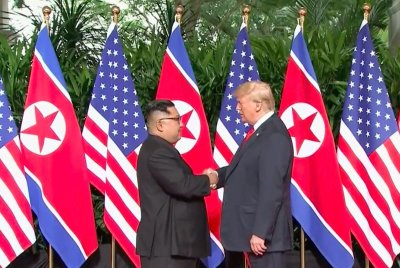N. Korea slams U.S. sanctions on Pyongyang, vows proper response

SEOUL, Nov. 6 (Yonhap) — North Korea on Thursday denounced the latest U.S. sanctions on Pyongyang as a demonstration of Washington’s hostile policy, vowing to take proper measures to counter it with patience.
The North’s reaction came as the U.S. announced Tuesday that it had imposed sanctions on eight North Korean individuals and two entities for their involvement in laundering money stolen through illicit cyber activities.
The sanctions came even as U.S. President Donald Trump has expressed his wish to meet with North Korean leader Kim Jong-un to resume stalled diplomacy with Pyongyang.
Kim Un-chol, North Korea’s vice foreign minister in charge of U.S. affairs, said in a statement that by imposing fresh sanctions, the U.S. has showed its “invariable hostile” intents toward North Korea in an “accustomed and traditional way,” according to the Korean Central News Agency (KCNA).
“Now that the present U.S. administration has clarified its stand to be hostile towards the DPRK to the last, we will also take proper measures to counter it with patience for any length of time,” the statement showed.
Denouncing the U.S. for revealing its “wicked nature,” the North’s official warned Washington should not expect its tactics of pressure, appeasement, threat and blackmail against North Korea will work.
“The U.S. sanctions will have no effect on the DPRK’s thinking and viewpoint on it in the future, too, as in the past,” Kim said, using the acronym of North Korea’s official name, the Democratic People’s Republic of Korea.
In regard to North Korea’s statement, South Korea’s unification ministry assessed the North appears to have responded to the imposition of U.S. sanctions in a “restrained” manner.
The U.S. move came as North Korea has not responded to Trump’s proposal to meet with the North’s leader during his latest trip to South Korea on the occasion of the Asia-Pacific Economic Cooperation (APEC) gathering.
Earlier this week the U.S. State Department also raised the need to seek U.N. sanctions on seven ships accused of illegally exporting North Korean coal and iron ore to China in violation of U.N. Security Council sanctions over the North’s nuclear and missile programs.
South Korea’s spy agency said this week there were signs that North Korea had been preparing for a possible meeting with the U.S. in time for last week’s APEC gathering.
The National Intelligence Service said there is a high possibility that the North and the U.S. would hold a summit some time after an annual joint military exercise between South Korea and the U.S. in March next year.
(END)
Copyright (c) Yonhap News Agency prohibits its content from being redistributed or reprinted without consent, and forbids the content from being learned and used by artificial intelligence systems.
